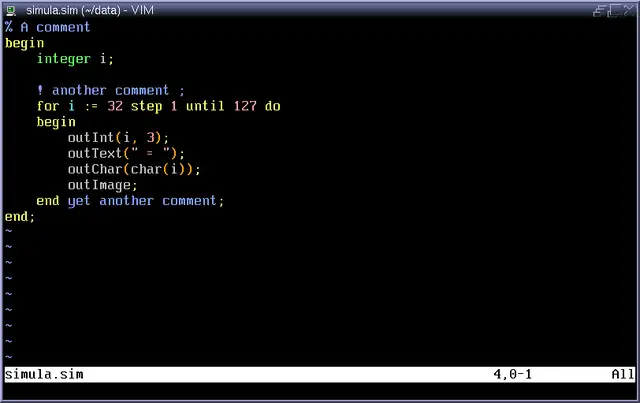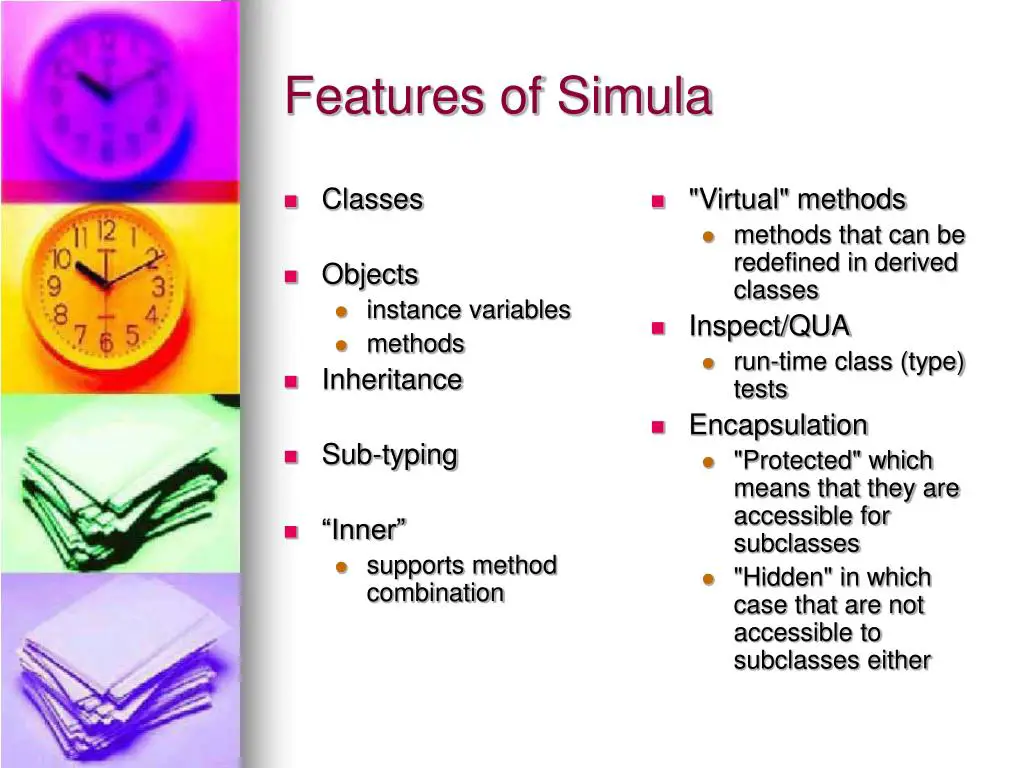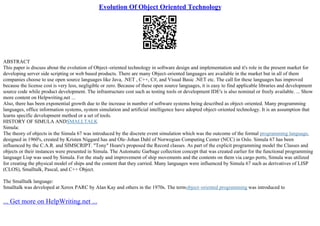Simula

Simula is a high-level programming language developed by Ole-Johan Dahl and Kristen Nygaard in the 1960s. It is considered one of the first object-oriented programming (OOP) languages and laid the foundation for modern OOP concepts.

Classes and Objects in Simula

Simula introduced the concepts of classes and objects as a way to organize and structure code.
- Class: A class defines a template or blueprint for creating objects. It contains member variables (data) and methods (functions) that define the behavior of objects created from it.
- Object: An object is an instance of a class. It has its own set of data and can execute the methods defined in its class.
Key Concepts of Classes and Objects
- Encapsulation: Classes allow data and methods to be grouped together and hidden from other parts of the program.
- Inheritance: Classes can inherit properties and methods from parent classes, enabling code reuse and extensibility.
- Polymorphism: Objects of different classes can respond to the same method call in different ways, based on their specific implementations.
Example
class Animal begin
real weight, height;
procedure eat; // Method to eat
procedure sleep; // Method to sleep
end;
begin
Animal dog; // Create an object of class Animal
dog.weight := 10; // Set the dog's weight
dog.eat; // Call the eat method of the dog
end;In this example, the Animal class defines two variables (weight and height) and two methods (eat and sleep). The dog object is created from this class and can access the methods and data defined within it.
Impact of Simula on OOP
Simula’s introduction of classes and objects had a profound impact on the development of OOP. It established the basic concepts that became the foundation for modern OOP languages, such as C++, Java, and Python.
Simula influenced the development of concepts such as:
- Encapsulation
- Inheritance
- Polymorphism
- Object-oriented design patterns
- Message passing and dynamic dispatch
These concepts have become integral to OOP and have transformed the way software is designed and implemented.## Simula And The Concept Of Classes And Objects
Executive Summary
Simula was the first programming language to introduce the concepts of classes and objects, which are fundamental to object-oriented programming (OOP). This article provides an overview of Simula, its role in the development of OOP, and its key features, such as classes, objects, inheritance, and encapsulation.
Introduction
Object-oriented programming (OOP) is a programming paradigm that emphasizes the use of classes and objects to structure code. The concepts of classes and objects were first introduced in the Simula programming language, developed in the 1960s by Ole-Johan Dahl and Kristen Nygaard.
FAQs
1. What is Simula?
Simula is a general-purpose programming language that introduced the concepts of classes and objects, which are fundamental to OOP.
2. What are the key features of Simula?
Simula’s key features include classes, objects, inheritance, encapsulation, and concurrency.
3. How did Simula contribute to the development of OOP?
Simula established the foundation for OOP and inspired the development of subsequent OOP languages, such as Smalltalk and Java.
Subtopics
Classes
Description: A class is a blueprint that defines the structure and behavior of objects. It encapsulates data and functions related to a specific type of object.
- Data Members: Variables that store data associated with objects.
- Member Functions: Functions that operate on data members of objects.
- Constructor: A special function that initializes an object when it is created.
- Destructor: A special function that deallocates resources when an object is destroyed.
Objects
Description: An object is an instance of a class that contains data and functions specific to that object. It represents a real-world entity.
- State: The data stored in the object’s data members.
- Behavior: The actions that the object can perform through its member functions.
- Identity: Each object has a unique identity that distinguishes it from other objects.
- Lifetime: The duration of an object’s existence in memory.
Inheritance
Description: Inheritance allows new classes (derived classes) to inherit properties and behaviors from existing classes (base classes). It promotes code reusability.
- Derived Class: A new class that inherits from a base class.
- Base Class: A class from which other classes inherit.
- Multiple Inheritance: A class that inherits from more than one base class.
- Single Inheritance: A class that inherits from only one base class.
Encapsulation
Description: Encapsulation hides the implementation details of an object from other parts of the program. It protects data integrity and promotes modularity.
- Public Interface: The part of an object that is accessible to other parts of the program.
- Private Implementation: The part of an object that is hidden from other parts of the program.
- Access Modifiers: Keywords (e.g., public, private) that control the visibility of data members and member functions.
Concurrency
Description: Simula introduced the concept of concurrency, allowing multiple tasks to execute simultaneously. It facilitated the development of real-time systems.
- Coroutine: A lightweight thread of execution that can be suspended and resumed.
- Process: A heavy-weight thread of execution that can run independently of other processes.
- Synchronization: Mechanisms to coordinate the execution of multiple processes or coroutines.
Conclusion
Simula’s introduction of classes and objects was a significant milestone in the development of OOP. It laid the foundation for the widespread adoption of OOP principles and paved the way for the creation of complex and maintainable software systems. Simula’s concepts continue to influence the design and implementation of modern programming languages and are essential for understanding the foundations of OOP.
Keyword Tags
- Class
- Object
- Inheritance
- Encapsulation
- Object-Oriented Programming
